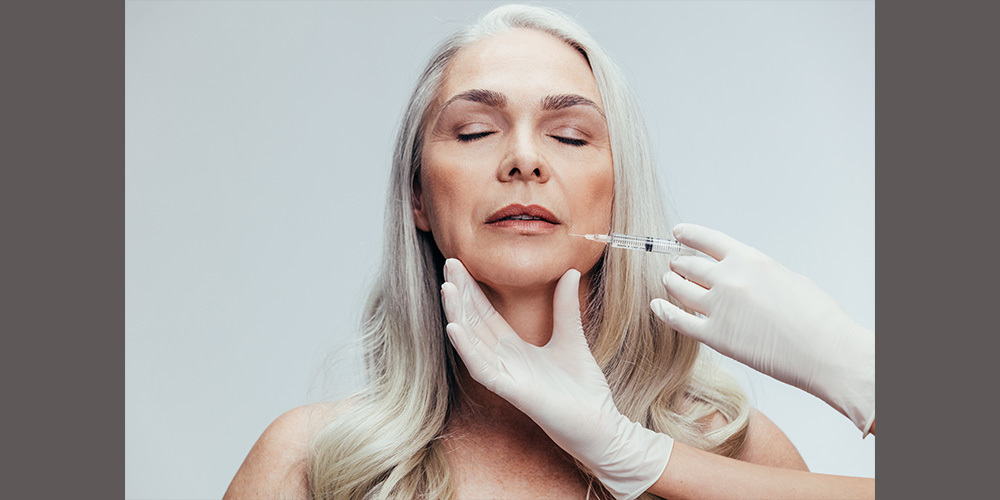
Clinical
Radiofrequency and Non-RF Microneedling Safety: What Patients Should Know
With Molly Muecke, RN, MSN, NP-CMicroneedling is a popular aesthetic treatment offered in 79% of med spas (2024 Medical Spa ...
Posted By Madilyn Moeller, Wednesday, October 19, 2022

By Madilyn Moeller
Soft tissue filler was injected in American faces more than 3.4 million times in 2020, according to the American Society of Plastic Surgeons. That’s just over one quarter of all minimally invasive cosmetic procedures reported in that year.
Training providers to inject dermal filler will continue to be a priority in medical spas for the foreseeable future, and injectors that are proficient with all the necessary implements will have a leg up.
Needles and cannulas are both essential tools for the aesthetic injector. Injectors may have their preferences, but experienced practitioners are trained to use both instruments as needed to provide safe, consistent results and make decisions in their patients’ best interests.
Medical practitioners are certainly familiar with the hypodermic needle, which injects or extracts fluids under the skin. These are the same needles used for vaccinations, and they have a beveled, sharp tip to pierce the dermis.
Microcannulas can extract and inject fluids like needles but have a blunt tip. Instead of fluid flowing out of the tip, microcannulas (hereafter referred to as “cannulas”) have a small port opening, called the lumen, near the end of the instrument. The placement of that opening means that product exits the cannula at a 90-degree angle, versus an angle closer to 10 degrees with a needle.
Needles and cannulas both come in a range of gauges to indicate diameter. For aesthetics use, injectors use 30 gauge at the skinniest and 22 gauge at the widest. Cannulas are often longer and can be one to two inches in length, depending on the size of the treatment area or desired precision.
Injection technique differs between needles and cannulas. When using a needle, the injector pierces the skin to place filler. Many techniques with a needle involve placing small boluses, or deposits, of filler. Injectors pierce the skin for each deposit of filler, resulting in multiple pokes.
To inject with a cannula, the injector first pierces the dermis with a needle to create a pilot opening. The injector then inserts the cannula through the opening, maneuvers it into position, and places filler according to their chosen technique. The cannula remains inserted and is constantly in motion during filler injection. Cannula users use a two-handed technique; the injector’s “smart hand,” the one not holding the syringe, helps them maneuver and feel where they are placing the tip of the cannula. Common filler techniques with a cannula include radial fanning, cross-hatching, bolus, linear threads and serial puncture. For one injection site, an injector will likely need only one pilot opening.
Where and why do seasoned injectors use one instrument or the other? Hermine Warren, DNP, APRN, CANS, Steven F. Weiner, MD, and Carl Clarke, MHS, RPA-C, filled QP in.
Clarke chiefly injects with a needle; Warren and Dr. Weiner primarily use the cannula for injecting dermal filler. They have been practicing in aesthetics since 2003, 2004 and 2005, respectively. As aesthetic injectors, practice owners and master trainers, each of them practice with an emphasis on atraumatic technique for safe, consistent results and the optimal patient experience.
Injectors trained in facial anatomy use the superficial musculoaponeurotic system (SMAS) as a depth gauge to avoid intravascular injections; this is also the area manipulated by plastic surgeons performing facelifts. Cannulas allow the injector to palpate the SMAS, giving them tactile feedback to ensure they are in the correct plane before placing product.
The cannula’s blunt tip also helps the instrument and placed filler to stay within the intended plane, even if there is retrograde flow, which is more likely with needles. Critically, a cannula’s blunt end is unlikely to puncture vessels and instead goes above or below them. This minimizes the risk of injecting intravascularly, although a small cannula and too much force can increase an injector’s chance of puncturing a vessel.
“I don’t use 27-gauge cannulas anymore,” says Dr. Weiner. “They have been shown to be a little more pointed, needle-esque, and need almost the same pressure to get into a vessel as a needle of the same size.”
Clarke notes that because cannulas push tissue around, an injector may not get through the fat into where they want to be.
“You think you are here, but your reality is you are still there because you haven’t penetrated and reached your location,” says Clarke. “You’ve only translocated the fat from one position to the other. And then you place your injection, meaning that you’re placing your injection a few millimeters behind your target site. Beginner injectors will not understand that.”
Cannulas vary in flexibility. Some are very stiff, and others are very flexible. A flexible cannula may fishtail; larger, small-gauge cannulas fishtail less. Clarke notes that a fishtailing cannula may deflect as an injector goes through tissue, impacting accuracy. “There are advantages for flexible cannula, just not in aesthetics,” he says.
A cannula’s added length requires injectors to use more extrusion force to push the product out, compared with shorter needles. Some cannulas have a slightly larger internal diameter than others of the same gauge to make this easier, but those instruments are more expensive.
The sharp end of a needle goes through tissue directly to the injection site. This precision is why injectors choose needles for fine lines and areas where the product needs to be placed very superficially.
“As this needle gets to where it wants to go, and you place your product, you are filling the specific spot that you have located that needs to be filled,” Clarke says. “The hypodermic needle will allow you pinpoint precision in placement of the product.”
A needle creates trauma to the tissue. “The hypodermic needle is cut on four sides. Those are four sides that create trauma as it’s going through the tissue,” says Clarke.
Dr. Weiner compares the trauma to cannula injection. “I have one entry point,” he says. “Let’s just say, for the lateral cheek, they might have five or six entry points per side. Each one of those has a propensity to have bruising or bleeding versus a cannula. You have the one and you slide it along the periosteum, and you could do it in a minute and a half per side.”
Needles can create soreness below the dermis as well; cannulas are less likely to do so with their rounded edge and the technique of sliding along the surface.
“When you’re going down on periosteum with a needle, it’s like taking your elbow and banging it on a table—you have a bone bruise because you’re going into bone with a sharp object,” says Warren. “Inevitably, even if you haven’t hit a vessel, the next day that person is going to say, ‘You know, I like the way I look, but I’m a little swollen and I’m sore.’ Certainly, they’ll have soreness.”
Another consideration with needle injection is the potential loss of product when changing needles, which is needed more often when the needle’s tip is blunted.
“Some needles, the tip bangs after the first injection; others don’t,” says Clarke. “Most hypodermic needles, after a few sticks, are of no more use, unless you keep jabbing. After a few sticks, you’re losing about 0.05 ccs of your product every time you change your needle. If you change your needle multiple times, you’re losing up to 5% of your product. So, you don’t want to change the needle that often.”
The most potent safety concern with needle injection is the chance for vascular complication by the injector puncturing a vessel. A 2021 study in JAMA Dermatology (Alam, et al) with data from 320 dermatologists showed vascular occlusion incidence of 1 in 6,410 needles and 1 in 40,882 cannula injections of dermal filler.
Dr. Weiner finds cannulas beneficial in the prezygomatic space, jawline, temples, mid-face, nasolabial folds and corners of the mouth. Warren also uses a cannula for the lips, but uses a needle for the vermilion border, cupid’s bow and columella.
“If you’re trying to treat really fine lines, get a needle,” says Dr. Weiner. “You can’t treat them superficially with a cannula. You have to use a needle.”
In areas with higher rates of vessel aberration, the injectors use caution and choose their instruments to minimize risk. Dr. Weiner says the deep pyriform is best served with a needle down to periosteum.
“I do check it with an ultrasound now because of that variation along the periosteum,” he says. “I think that it’s a lot higher than the literature states. I just had three in the last two days along the periosteum.”
Dr. Weiner and Warren do not inject the nose, but injectors who make a living injecting noses, almost without an exception, use a needle.
“It’s one of the highest risk areas for occlusions,” says Dr. Weiner. “There is actually one study to suggest that a cannula is not as safe as a needle in the nose because of the radix, the curve. As the cannula goes over it, it shifts it out of the supraperiosteal plane and into an area where the potential for injecting an artery is. So, there are some areas, although that’s the only one I can think of, where a needle is probably safer than a cannula.”
Choosing the appropriate gauge allows injectors to produce better outcomes by creating different shapes or applying the product differently.
“Picking the right hypodermic needle is also important because using a 30 gauge, for example, to inject the lips versus a 29 gauge gives different outcomes,” Clarke says. “Using a 27 gauge would also give a different outcome because the product is coming out slightly different.”
Clarke uses a cannula in the temples and sometimes the lower cheek hollows, and that’s it.
“Those are the only places I would use my cannula,” he says. “Why? It’s very atraumatic. I don’t have to worry about any bleeding or bruising. I’ve never had bleeding or bruising from my temple injection.”
Needle and cannula are sometimes used in combination. Dr. Weiner uses cannulas for at least a portion of the correction and may follow up with needles to fine-tune.
“You can actually use both in certain areas,” he says. “Sometimes around the temples, you do a deep injection with a needle and a superficial injection with a cannula; same thing with the mandible, or the jawline.”
The filler’s rheological properties can also determine which instrument needs to be used. Needles make it easier to achieve steady flow rates for soft tissue filler. A viscous filler will require a larger cannula.
Cannulas can cover large areas with ease. Linear threading over a large area with a cannula makes sense because the injector introduces less trauma, though Clarke suggests that atraumatic needle techniques may produce a better result.
Dr. Weiner places an emphasis on the patient experience and finds that cannula injection can be more comfortable for the patient.
“I believe that not only is it safer, but you have less discomfort, less swelling and less bruising when you are using cannula versus needle, because you have the one entry point and you are less likely to traumatize vessels or arteries,” says Dr. Weiner. “Overall, I believe the patient’s entire experience with the injections in my hands is shorter, less painful and leads to less swelling and less bruising. That’s a huge deal, because I’m all about the patient experience, and the patient experience isn’t just the injections—it’s the post-operative or post-procedure care, as well.”
Patients can still bruise with a cannula injection, but this is usually the result of the pilot opening. Injectors will pierce deep in their area, right into a vessel, and the patient is left with a bruise not from the cannula usage but from the port of entry. Warren says that mistake often comes from the injector not assessing where they are going.
Patients who were previously injected using needles tell Warren they did not think you could have these kinds of treatments and not get badly bruised. She explains that their other provider was a great injector, but bruising happens.
“Look at the law of averages,” she says. “If you’re doing five to 10 different pokes in one area versus one, I have a lot better odds statistically [as a cannula user] to not bruise the patient than someone who’s sticking a needle over and over again.”
Clarke finds that some injectors use a cannula out of the fear of causing side effects, rather than for technique-driven motivations.
“Many practitioners would veer to the side of a cannula because it gives them less trauma, but that’s not the reason to use a cannula,” he says. “If that’s the case, then work on the technique so you are less traumatic to the individual. But, if you use your cannula because you are afraid of side effects that you cause, that’s the wrong reason to use a cannula.”
Most patients, Clarke says, will report negative outcomes at some point in their treatments, and that is because of the techniques used. Ninety-nine percent of trainers teach the five basic injection techniques, he says, most of which are the same techniques they learned in the early 2000s, and those led to a lot of adverse events.
“Overall, what has to occur with the techniques is to reduce the trauma and not to regurgitate the same techniques,” Clarke says. “We want to get better as we go ahead. And if we’re not forcing ourselves to get better, 50 years from now, we are going to be doing the same techniques. That doesn’t make as much sense.”
The experience and training needed to use either instrument are relative. Dr. Weiner thinks an injector needs a lot more finesse when using a cannula versus a needle. Clarke says needle training is straightforward, but fine needle manipulation and fine hand movement is needed to reduce side effects and inject exactly where you want to be.
Many injectors start their aesthetic career with a needle. When learning to use a cannula, they need to get accustomed to using it, making pilot openings just right and adopting new techniques. Even though they may find the learning curve humbling, a newer cannula user should not give up, says Warren.
“One thing I always say to newer injectors is that what differentiates a newer injector from a seasoned injector is newer injectors watch their instrument, and seasoned injectors watch the skin,” she says. “They’re not watching their syringe or their cannula. They’re watching what’s happening to what they’re doing. I think that’s the cognizance that’s important to impart educationally with whatever tool you are using: to watch what’s happening, to be slow, to be candid and to have a moving needle or cannula so that you really can see if you are creating the potential of occlusion.”
On the topic of occlusion, it is important for injectors to be ready to address adverse events. Cannula or needle, Warren thinks ultrasound is a key component to helping clinicians have a better understanding of how to rid themselves of a problem if one arises.
“I think a lot of people think if they have a tool, they’re safe,” she says. “They don’t have the supporting things that make the cannula or needle an okay tool—they just have their gumption to do it and their protocols, but they don’t even have dissolvent in their office or the right amounts. I think that’s a really important thing to bring home. You need to really understand what it means to take care of the complications of those two tools effectively. That’s critical.”
Dr. Weiner trains his practice’s providers on cannula from day one. Warren also suggests that people start to use cannulas from the outset. Clarke feels that every practitioner should know how to use a cannula but believes it may be difficult for new injectors to learn both cannula and needle injection techniques at the same time.
“I think the benefit of having an incredible injector is that you have a very diverse set of tools you can use,” says Warren. “If you’re only a cannula user, I think you’re limited. If you’re only a needle injector, I think you’re limited. If you have the use of both, then you can do whatever percentage you want to do.”
As skilled injectors and aesthetic trainers, Warren, Weiner and Clarke are trusted leaders in this space. They offered some final thoughts.
Warren wishes that the product manufacturers would routinely get FDA approval for both needle and cannula injection. This would allow trainers to teach cannula injections on-label.
“I’m always profoundly disappointed when a company gets an FDA approval in an area, and they’ve done it only with a needle when it would be so much safer with a cannula,” she says. “It just makes all the difference in the world.”
Dr. Weiner emphasizes the value of cannulas in their benefit for the patient.
“I think that it should be part of every injector’s armamentarium,” he says. “The outcomes, the patient experience and the safety dictate that one become comfortable using cannulas in your patients. It’s not for every location and sometimes combination therapy is useful, but you should incorporate it into your injection techniques.”
Clarke says that whether with a cannula or needle, atraumatic technique is always necessary, and he wants injectors to leave his training with consistent results and consistent technique.
“Everything fits together like gears in an engine,” he says. “The anatomy has to be there. The technique has to be there. Choosing the right product has to be there. The consultation and the patient management have to be there. So, whatever you can do to get that consistency means that everything has to work nicely in place. It is the consistency that I talk about. It’s not just a decent result here and there; it’s consistency.”
Learn more from the experience of these talented aesthetic injectors at an upcoming Academy for Injection Anatomy course in your region.
AmSpa Members receive QP every quarter. Click here to learn how to become a member.
Related Tags
Medical spa news, blogs and updates sent directly to your inbox.

Clinical
With Molly Muecke, RN, MSN, NP-CMicroneedling is a popular aesthetic treatment offered in 79% of med spas (2024 Medical Spa ...

Clinical
On November 5, 2025, Merz Aesthetics announced that Ultherapy PRIME® gained U.S. Food and Drug Administration (FDA) clearance to improve ...

Clinical
By Belmar Pharma SolutionsWhen it comes to menopause, a once-taboo topic, the tide has finally changed. Women now have access ...

Clinical
The FDA’s recent safety communication regarding radiofrequency (RF) microneedling devices is a critical reminder: Aesthetic treatments involving energy-based devices are ...